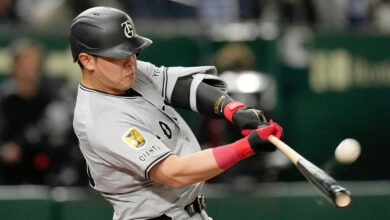
Kris Bryant Defying League Strikeout Trends in a Big Way
Kris Bryant was supposed to be the embodiment of a new generation of hitters, a group of sluggers for whom strikeouts were not only acceptable, but almost encouraged. After all, whiffs don’t smell quite as bad to sabermetric noses. And when he won the Rookie of the Year award despite swinging and missing 66 percent more frequently than the league average, KB lent all kinds of credence to the idea that the K is OK.
But to assume he’d be happy just putting up nearly 200 strikeouts a season is to misunderstand what makes Bryant tick. He’s not happy with the status quo, even when maintaining it means being the best player in the league. So he went to work after his rookie campaign and closed some of the holes in his swing.
The results were somewhat pedestrian, just an NL MVP and the Cubs’ first World Series in a number of years Cardinals fans enjoy referencing ad nauseam. But what’s really impressive about Bryant cutting his strikeout total by 45 despite logging 49 more plate appearances is that he did it at a time when the rest of the league was moving in the opposite direction.
And what’s even more impressive is that both trends are continuing in opposite directions, with Bryant improving his swinging strikes as the rest of MLB gets worse in that regard. That is all a result of his offseason work back in Las Vegas with his father, Mike Bryant.
“If you’re too much vertical you have a lot of swing-and-miss in your game,” the elder Bryant told CI last year. “So my goal was really simple: To reduce the swing-and-miss in the zone; to get him from chasing pitches out of the zone; and to hit more balls in the air. I want a higher ratio of balls in the air to balls on the ground.”
“I didn’t set out a goal to come right out and say, ‘Hey, look: We’re going to increase your contact percentage four-fold, okay?’ I was looking just to take his strikeout rate down 20 percent. Well, mission accomplished.”
All that work father and son put in following the 2016 season to close holes in the MVP’s swing once again reduced his strikeouts and helped him to put up better offensive numbers in several categories. It wasn’t enough, though, which is why they got back in the cage to further improve Bryant’s pitch recognition.
“Better zone coverage, hitting everything (to) center/right-center,” Mike told CI prior to spring training. “More high line drives than lifting the ball. Focusing on pitch recognition by seeing it and tracking it.
“Tracking the ball is just part of an approach that raises one’s awareness level, trying to see the spin on it as early as one can.”
Though he didn’t really come out and say it himself, Bryant came into the season with a goal to achieve a 1:1 strikeout-to-walk ratio. Having more walks than strikeouts has long been a sign of an excellent hitter, but it’s nearly unheard-of for a slugger in today’s game. Just consider that only 14 players have achieved such a mark in the time since Bryant debuted (min. 250 plate appearances).
For Bryant to do this at all is impressive enough in and of itself. When you factor in his own history and the trajectory of the rest of the of the league, it’s downright inconceivable. Maybe not scoring-nine-runs-in-an-inning-to-shock-the-Braves level crazy, but it’s really flippin’ impressive. Just take a look at the rudimentary chart below for a little more on exactly what Bryant has been able to do relative to his peers (which is actually a misnomer, because most of these guys aren’t really his peers).

It’s probably too early to get super excited about this year’s nice numbers, which have come from a mere 69 plate appearances. Still, seeing Bryant with 10 walks against only eight strikeouts is highly encouraging. It’s also somewhat predictable, even in light of what I just wrote about how his improvements in swinging strikes are hard to believe.
And therein lies what I like to call the Bryant Paradox, a contradiction of expectation and reality made possible by a freakishly talented ballplayer who’s also committed to constantly improving his game. That’d be one thing if we were talking about a guy who needed to get better just to hold down a roster spot, but simply extrapolating his rookie season would have placed Bryant on a path to Cooperstown.
Rather than work to simply reach his ceiling, Bryant enlists the help of a contractor to raise the height of his ceiling each offseason. By the time he’s done playing, he’ll be decorating the penthouse suite of a skyscraper.
You can almost see him improving on a daily basis and it’s one of my great joys to watch Bryant learn and grow as a hitter and also a leader. It’s got nothing to do with his performance at the plate, but stepping up as the Cubs’ MLBPA player rep was great to see as well. Hey, maybe he can help cut down on strikes in that role as well.

